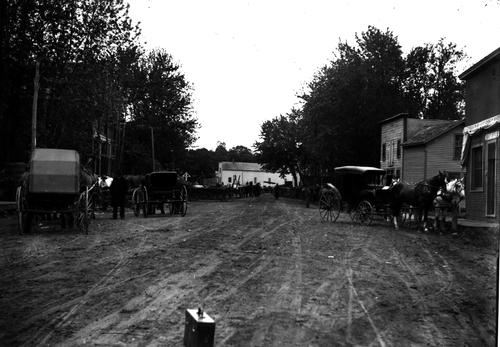Indexes
Lake Elmo was part of Oakdale Township until 1951 when the township separated into Oakdale and East Oakdale. In 1925 the small commercial district incorporated as a village and in 1972 the village and East Oakdale Township joined to become the City of Lake Elmo.
First to settle in the area in 1848 were Virginians Bernard B. “Bun” Cyphers and his wife Maria, who built a hotel, tavern, and stage stop, known as the Lake House, south of Sunfish Lake on the first road to be surveyed through the township. By 1850 the Stillwater Road, corresponding more to less to Highway 5, had been constructed. It was used for many years by the Willoughby & Powers stage coaches taking passengers between St. Paul and Stillwater.
In 1876 a post office was established at Bass Lake Station, now known as Lake Elmo village. The Lake House became the town meeting site in the 1860s, and was also used as the District 12 school.
Bass Lake, the original name of the lake, was noted for its fresh water and good fishing. Both lake and village were renamed Lake Elmo in 1879 by railroad promoter and St. Paul businessman, Alpheus B. Stickney, as being more euphonious.
Lake Elmo became a popular summer resort. There were many livery stables in St. Paul and Stillwater and a large part of their business was taking people out to Lake Elmo. In 1872 the St. Paul, Stillwater & Taylor’s Falls Railroad (later the Omaha Road) passed through Lake Elmo, making it easy for tourists from St. Paul to reach the lake. A. B. Stickney was presumably acting for the railroad when he purchased the land between the railroad tracks and the lake. There he built an “elegant and spacious” 58-room lake hotel. Probably Stickney’s influence caused the county fair grounds to be built on land he owned at Lake Elmo in 1875. In 1876 at the fair, baseball was the game and there were matches every day. Unfortunately in 1877, a tornado hit the fairgrounds and the fair was moved to Stillwater.
Lake Elmo enjoyed a decade of solid success with its well-publicized resort hotel, but attempts to build a cottage community around the lake generally did not succeed. The most ambitious was the Elmo Residence Park, platted in 1884 around the eastern side of the lake. Several cottages, a bandstand, and clubhouse were completed.
By the early 1890s streetcar companies were extending their lines to lakes close to the cities. Unfortunately for Lake Elmo, the streetcar line to Stillwater was run through Mahtomedi, which became the new pleasure grounds. Lake Elmo, which had to depend upon railroads and stage coaches, lost popularity as a resort.
In the early days, the Lake Elmo commercial center, which grew up around the railroad station, boasted a store, saloon, a “flat” grain house where farmers could unload wagons directly onto the trains, a blacksmith, and a wagon repair shop. In 1888 the Iowa Land Company bought Stickney’s property and the adjoining Lohmann farm, platted the area and laid it out into lots. By the 1920s the Stillwater Road had been paved and the village was established as a substantial shipping point and dairy center that boasted a creamery, grain elevator, two grocery stores, hardware and implement stores, a private hospital, a bank, a garage, and even a roller skating rink. The downtown area was platted as Lake Elmo Village in 1925, the year a second creamery, the Twin City Milk Company plant, was built.
Many of the early farmers were Germans, and there were several Irish families, but there were few of the Yankees so prevalent on the St. Croix River. Several farmers specialized in Jersey and Holstein cattle and Yorkshire swine. Among these was William Moscrip, who developed a modern dairy facility now known as North Star Farms east of Sunfish Lake, which he sold in 1948 to Leo Shiltgen.
Lake Elmo gradually lost its importance as an agricultural center, but began to see residential growth as suburban development moved eastward from St. Paul. One of the most ambitious projects of the 1960s was Cimarron, a planned community of manufactured homes next to a golf course south of the village. The construction of Lake Elmo Airport (actually in Baytown) in 1952 kept the city on the map. Today much of the city is taken up by Lake Elmo Regional Park Reserve, on the western shore of Lake Elmo.
In general, Lake Elmo has elected to remain rural, limiting the typical suburban development overtaking much of the rest of the county. Its population growth, from 5,900 to 7,900 in 2005, has been contained. However, Lake Elmo is planning for strong growth over the next two decades, including development of the Historic Old Village area.
Historic Sites in Lake Elmo
Relevant Online Indexes
- 1881 Washington County History
- 1901 Northwest Pub. Plat Book
- Christ Lutheran Church cemetery
- Names in WCHS Scrapbook Index
- Poor Farm deaths compiled by WCHS
- Poor Farm Register, Volume 1
- Stillwater Gazette Photo Collection
- St. Lucas United Church of Christ cemetery
- Washington County in the World War, 1917-1918-1919
- WCHS Biographic Files
- WCHS Deeds
- WCHS Photograph Collection
- WCHS School Scrapbook
